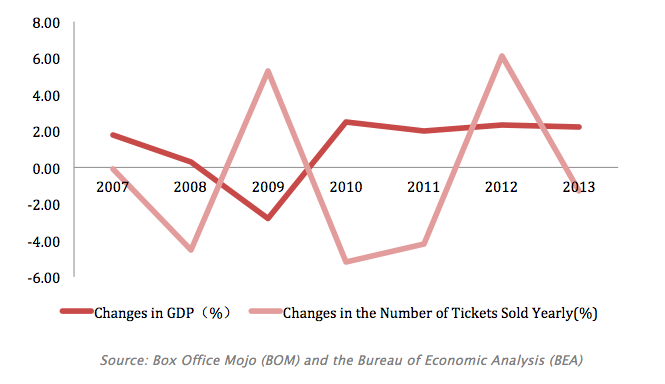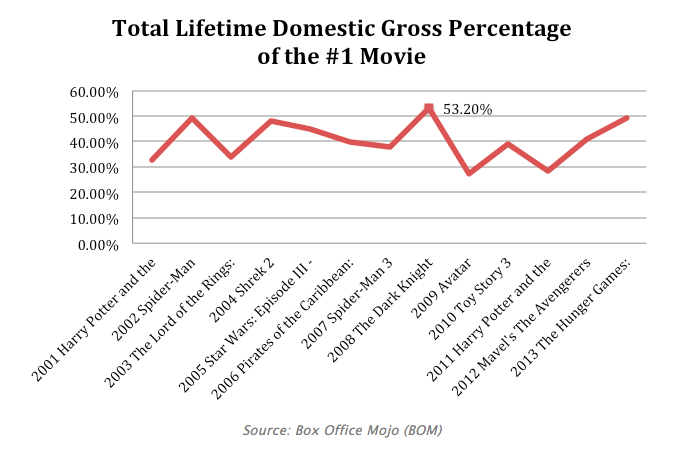History tells us that recessions and Hollywood is like Oreo and milk – the perfect combination. Why? The above graph shows yearly changes in Gross Domestic Production (GDP) compared to the previous year and the number of movie tickets sold in the U.S in recent years. We can easily tell that, in most cases, consumers’ desire for movies is negatively correlated with the general economic environment. Namely, when people are “rich,” they’re more likely to splash out in town; while “they lose where they are, they go into the movie,” said Jeanine Basinger, a film historian and chairwoman of the film studies department at Wesleyan University in Connecticut.
Surely there’re exceptions, but Box Office doesn’t depend solely on GDP. Factors like the annual movie market situation and the quality of movies cannot be ignored. In 2008, the Great Recession began. However, from the first graph at the beginning, it seems that people didn’t go to theatres much at that time – but did they? According to Box Office Mojo, the number of movie tickets sold in 2008 was $1341.3 million, which was the lowest since 1996. But if we take a close look at statistics from the highest grossing movies in 2001 to 2013, American’s spending on The Dark Knight, the top box-office movie in 2008, has taken up 53.2% of the global market, which was the highest since 2001 – even Avatar was defeated! Perhaps the general movie quality in 2008 was just so-so, and that was the reason why people wouldn’t watch more movies. However, no matter what reason it was, we can see that in most of the time, recessions give Hollywood kisses and hugs.
Some might argue that they watch fewer movies now than they did before recessions. Indeed, a poll conducted by Harris Interactive shows that 55% of people go to movie theaters much fewer than before. But another factor that affects box-office should be taken into consideration as well – the changes in ways of how people consume movies. At early times, people could only enjoy movies at cinemas. Then, Digital Video Disk (DVD) was invented – people could buy or rent movies to watch at home. Now, there’s Netflix!
Netflix, Inc. is one of the top providers of on-demand Internet streaming media. It offers Hollywood another way to take a place in consumers’ life. Just take a look at how fast it’s been growing. Netflix’s revenue in 2013 was $4374.56 million, which was 28 times that in 2002. Up to the end of 2013, the number of subscribers of Netflix has reached 31.7 million. But it doesn’t stop there. Netflix has topped Q2 domestic subscriber growth targets in 2014 by 9.6%, and added another 570,000 U.S. streaming customers to the company – and counting.
“Many feel like recession still hasn’t ended,” this is the headline of a news report written by John W. Schoen on January 1, 2014 in USA Today. However, it seems that people’s passion for movies doesn’t fade even so. Maybe for a large number of people, going into “another world” by watching movies, or an inexpensive night at home with couple of drinks can be an escape, a solution or some kind of comfort against influences they get from the not-so-promising economy. Perhaps we can say that Hollywood is shelter for people to hide in, especially when they’re suffering from gloomy economic environment.



Leave a Reply
You must be logged in to post a comment.